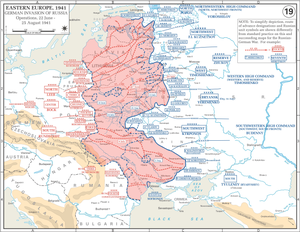1st Panzer Army
This article includes a list of general references, but it lacks sufficient corresponding inline citations. (November 2011) |
| 1st Panzer Army | |
|---|---|
| 1. Panzerarmee | |
Panzer | |
| Role | Armoured warfare |
| Size | Army 1 July 1942 (start of Case Blue): 226,688[1] 1 November 1943 (Battle of the Dnieper): 282,175[2] 1 March 1944 (Dnieper-Carpathian Offensive): 211,545[3] 1 May 1944 (after the battle of the Kamenets-Podolsky pocket) 172,541[4] |
| Engagements |
|
| Commanders | |
| Notable commanders | Ewald von Kleist |
The 1st Panzer Army (German: 1. Panzerarmee) was a German tank army that was a large armoured formation of the Wehrmacht during World War II.
When originally formed on 1 March 1940, the predecessor of the 1st Panzer Army was named Panzer Group Kleist (Panzergruppe Kleist) with Colonel General Ewald von Kleist in command.[5]
Service history
Panzer Group Kleist was the first operational formation of several Panzer corps in the Wehrmacht. Created for the
1941
In May 1941 Panzer Group 1 was attached to Field Marshal
1942
In January 1942, Army Group Kleist, which consisted of the First Panzer Army along with the
In September 1942, the offensive by Army Group A stalled in the Caucasus and List was sacked.
1943
In January 1943, von Mackensen's First Panzer Army became attached to
1944
The First Panzer Army remained attached to
1945
During its existence, from October 1941 to May 1945, the First Panzer Army spent its entire time on the
Commanders
| No. | Portrait | Commander | Took office | Left office | Time in office |
|---|---|---|---|---|---|
| 1 | Generaloberst Ewald von Kleist (1881–1954) | 1 March 1940 | 21 November 1942 | 2 years, 265 days | |
| 2 | Generaloberst Eberhard von Mackensen (1889–1969) | 21 November 1942 | 29 October 1943 | 342 days | |
| 3 | Generaloberst Hans-Valentin Hube (1890–1944) | 29 October 1943 | 21 April 1944 † | 175 days | |
| 4 | Generaloberst Erhard Raus (1889–1956) [22] | 21 April 1944 | 15 August 1944 | 116 days | |
| 5 | Generaloberst Gotthard Heinrici (1886–1971) | 15 August 1944 | 19 March 1945 | 216 days | |
| 6 | 19 March 1945 | 8 May 1945 | 50 days |
Chiefs of the general staff
- Generalmajor Kurt Zeitzler (creation – 24 April 1942)
- Generalmajor Ernst-Felix Fäckenstedt (24 April 1942 – 15 March 1943)
- Generalmajor Walther Wenck (15 March 1943 – 15 March 1944)
- Generalmajor Carl Wagener(15 March 1944 – 5 November 1944)
See also
- Battle of Uman
- Kamenets-Podolsky pocket
Notes
- ^ Liedtke, Gregory. Enduring the Whirlwind: The German Army and the Russo-German War 1941-1943. Wolverhampton Military Studies, 2016, p. 228.
- ^ OKH Org.Abt. I Nr. I/5645/43 g.Kdos. Iststärke des Feldheeres Stand 1.11.43. NARA T78, R528, F768.
- ^ OKH Organisationsabteilung (I). Nr. I/161628/44 g.Kdos. Notiz. Iststärke des Feldheeres Stand 1.3.1944. Bundesarchiv-Militärarchiv (BA-MA) RH 2/1341, fol. 12.
- ^ OKH Organisationsabteilung (I). Nr. I/17246/44 g.Kdos. Notiz. Iststärke des Feldheeres Stand 1.5.1944. Bundesarchiv-Militärarchiv (BA-MA) RH 2/1341, fol. 18.
- ^ Nipe 2012.
- ^ Battistelli 2012, p. 11
- ISBN 978-0-85045-958-6.
- ^ Mitcham 2006, p. 258
- ^ a b Ziemke 2002, p. 17.
- ^ Ziemke 2002, pp. 18–19.
- ^ Ziemke 2002, pp. 19, 3–4.
- ^ Ziemke 2002, p. 71.
- ^ a b Ziemke 2002, p. 85.
- ^ Ziemke 2002, pp. 86, 85.
- ^ Ziemke 2002, pp. 94–96.
- ^ Ziemke 2002, pp. 138.
- ^ Ziemke 2002, pp. 184–185.
- ^ Ziemke 2002, p. 280.
- ^ Ziemke 2002, p. 282.
- ^ Ziemke 2002, p. 286.
- ^ Ziemke 2002, p. 359.
- ^ Raus 2003, p. 353.
References
- Barnett, Correlli. Hitler's Generals. New York: Grove Weidenfeld, 1989.
- Battistelli, Pier Paolo (2012). Panzer Divisions: The Blitzkrieg Years 1939–40. Osprey. ISBN 9781472800824.
- Mitcham Jr., Samuel W. (2006). Panzer Legions: A Guide to the German Army Tank Divisions of World War II and their Commanders. Stackpole Books. ISBN 9781461751434.
- George M. Nipe (2012). Decision in the Ukraine: German Panzer Operations on the Eastern Front, Summer 1943. Stackpole Books. ISBN 978-0811711623– via Google Books.
- Raus, Erhard (2003). Panzer Operations: The Eastern Front Memoirs of General Raus, 1941–1945. Cambridge: Da Capo Press. ISBN 978-0-306-81247-7.
- Ziemke, Earl F.; Bauer III, Magna E. (1987). Moscow to Stalingrad: Decision in the East. Washington D.C.: Center of Military History, US Army. ISBN 9780160019425.
- Ziemke, Earl F. (2002). Stalingrad to Berlin: The German Defeat in the East. Washington D.C.: Center of Military History, US Army. ISBN 9781780392875.






